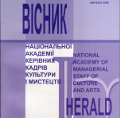ФОРТЕПІАННІ КОМПОЗИЦІЇ А. ШТОГАРЕНКА, ПЛАТОНА І ГЕОРГІЯ МАЙБОРОДІВ, А. КОС-АНАТОЛЬСЬКОГО У ВИРАЖЕННІ СТИЛЬОВИХ ОЗНАК ТРАДИЦІОНАЛІЗМУ
Piano Compositions by A. Shtoharenko, Platon and Heorhii Maiborod, A. Kos-Anatolskyi in Expression of Traditionalism Stylistic Features
Author(s): Liudmyla IvanovaSubject(s): Music, History of ideas, Sociology of Culture, Sociology of the arts, business, education, Sociology of Art, History of Art
Published by: Національна академія керівних кадрів культури і мистецтв
Keywords: Traditionalism; style in music; musical genre; piano playing style; pianism;
Summary/Abstract: The purpose of the article is to reveal in the works of A. Shtoharenko, brothers Platon and Heorhii Maiboroda, A. KosAnatolskyi, who are bright representatives of the traditionalist worldview, typical for them general stylistic ways of embodiment of the demands of the present day, using certain achievements of modernism, but not going beyond the traditionalist artistic position. The methodological basis of the work is based on the principles of the intonation approach, that is, based on the understanding of the genetic unity of speech and music, which is characterised by an organic complex interdisciplinary coverage of expressiveness of words, music, and imagery. This vision of musical expression coincides with modern art history research methods, among which we highlight historical-musicological, genre-stylistic, interpretive-hermeneutic, and semiotic-aesthetic. O. Markova’s metaphysics of musical history has become the methodological basis of the research [7]. The scientific novelty of the obtained results lies in the expansion of ideas about modern musical dimension of the stylistic heritage of the last century as the embodiment of the aprogressive paradigmatic principle of expression of traditionalism of the 20th century, with the awareness of the epochal «vibration» of the identification of the specified stylistic quality depending on the specifics of the nationwide manifestation of the corresponding thought stereotypes. Conclusions. The named masters consciously gravitated towards the academic stability of the expressive principles of music, but in no way bypassing the echo of the «call of time» and investing in their compositions more often impressionistic-fauvist, pro-neoclassical, and primitivist stylistic indicators. The salon slant of the applied piano is something that is permanently established in the palette of presented images-meanings, in which not so much folklorism, but precisely the lyrical excess of exposition is combined with sonata-like structures, «extinguishing» dramatic and theatrical expressiveness.
Journal: Вісник Національної академії керівних кадрів культури і мистецтв
- Issue Year: 2023
- Issue No: 1
- Page Range: 247-252
- Page Count: 6
- Language: Ukrainian

